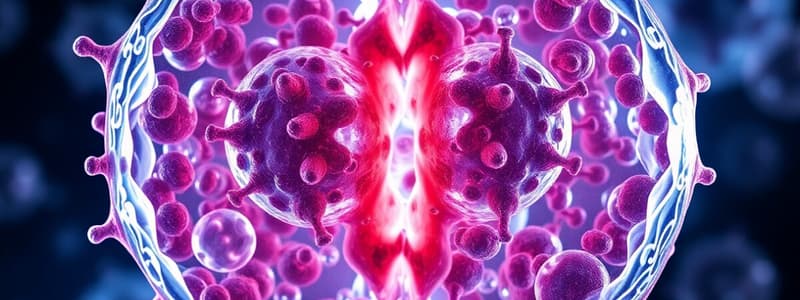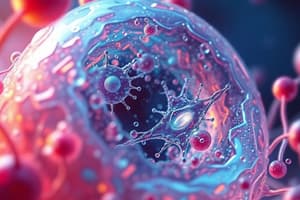Podcast
Questions and Answers
Who coined the term 'cells'?
Who coined the term 'cells'?
- Theodor Schwann
- Robert Hooke (correct)
- Matthias Schleiden
- Rudolph Virchow
Who was the first to observe living cells through a microscope?
Who was the first to observe living cells through a microscope?
- Matthias Schleiden
- Rudolph Virchow
- Theodor Schwann
- Anton van Leeuwenhoek (correct)
What does the Cell Theory state about living things?
What does the Cell Theory state about living things?
- All living things can exist without cells.
- All living things are composed of cells. (correct)
- All living things are composed of tissues.
- All living things are composed of molecules.
According to the Cell Theory, what is the basic unit of life?
According to the Cell Theory, what is the basic unit of life?
What does Cell Theory state about the origin of cells?
What does Cell Theory state about the origin of cells?
What is the first step in the binary fission process?
What is the first step in the binary fission process?
What occurs after the cell growth in binary fission?
What occurs after the cell growth in binary fission?
What is produced as a result of binary fission?
What is produced as a result of binary fission?
Which statement accurately describes the appearance of a cell during binary fission?
Which statement accurately describes the appearance of a cell during binary fission?
In binary fission, what best describes the role of DNA?
In binary fission, what best describes the role of DNA?
Which of the following structures is present in eukaryotic cells?
Which of the following structures is present in eukaryotic cells?
What distinguishes prokaryotic cells from eukaryotic cells?
What distinguishes prokaryotic cells from eukaryotic cells?
What type of cell structure is associated with bacteria?
What type of cell structure is associated with bacteria?
Which of the following is a characteristic of eukaryotic cells?
Which of the following is a characteristic of eukaryotic cells?
Who is credited with the discovery of eukaryotic cells?
Who is credited with the discovery of eukaryotic cells?
What is the primary function of ribosomes?
What is the primary function of ribosomes?
What does the cell membrane do?
What does the cell membrane do?
Which organelle is known as the powerhouse of the cell?
Which organelle is known as the powerhouse of the cell?
What is the role of the nuclear pores?
What is the role of the nuclear pores?
What is the primary function of the smooth endoplasmic reticulum?
What is the primary function of the smooth endoplasmic reticulum?
What is the primary function of cilia in a cell?
What is the primary function of cilia in a cell?
Which component of the cell is responsible for controlling movement within the cell?
Which component of the cell is responsible for controlling movement within the cell?
What structural feature is unique to plant cells?
What structural feature is unique to plant cells?
What process describes the movement of molecules from an area of high concentration to an area of low concentration?
What process describes the movement of molecules from an area of high concentration to an area of low concentration?
What is the function of chloroplasts in plant cells?
What is the function of chloroplasts in plant cells?
What is the primary function of chloroplasts in a plant cell?
What is the primary function of chloroplasts in a plant cell?
What does the term 'equilibrium' refer to in the context of concentration?
What does the term 'equilibrium' refer to in the context of concentration?
What is passive transport primarily characterized by?
What is passive transport primarily characterized by?
What is the relationship between diffusion and kinetic energy?
What is the relationship between diffusion and kinetic energy?
What does the concentration of a solution measure?
What does the concentration of a solution measure?
What is the primary movement of water during osmosis?
What is the primary movement of water during osmosis?
What happens to a cell placed in a hypertonic solution?
What happens to a cell placed in a hypertonic solution?
Which of the following statements about isotonic solutions is true?
Which of the following statements about isotonic solutions is true?
What effect do cold conditions generally have on molecules?
What effect do cold conditions generally have on molecules?
What is turgor pressure?
What is turgor pressure?
What effect does an increase in temperature have on the rate of diffusion?
What effect does an increase in temperature have on the rate of diffusion?
Which process is responsible for the uptake of small particles into a cell?
Which process is responsible for the uptake of small particles into a cell?
How do carbohydrate chains and protein channels function in facilitated diffusion?
How do carbohydrate chains and protein channels function in facilitated diffusion?
Which factor affects the diffusion rate by determining how quickly a molecule can move through a medium?
Which factor affects the diffusion rate by determining how quickly a molecule can move through a medium?
What is the main purpose of endocytosis in a cell?
What is the main purpose of endocytosis in a cell?
What is the effect of placing a cell in a hypotonic solution?
What is the effect of placing a cell in a hypotonic solution?
What occurs during plasmolysis in a cell?
What occurs during plasmolysis in a cell?
In the process of osmosis, water moves from which area?
In the process of osmosis, water moves from which area?
Which description best illustrates cytolysis?
Which description best illustrates cytolysis?
The term 'plasmolysis' refers to the process where:
The term 'plasmolysis' refers to the process where:
What type of transport moves materials from high concentration to low concentration without the use of energy?
What type of transport moves materials from high concentration to low concentration without the use of energy?
Which process requires energy to move sodium out of the cell and potassium into the cell?
Which process requires energy to move sodium out of the cell and potassium into the cell?
What is the main characteristic of endocytosis?
What is the main characteristic of endocytosis?
Which of the following describes pinocytosis?
Which of the following describes pinocytosis?
Which statement accurately describes the sodium-potassium pump?
Which statement accurately describes the sodium-potassium pump?
Flashcards
Cell Theory
Cell Theory
The idea that all living things are made up of one or more cells.
Robert Hooke
Robert Hooke
A scientist who observed cells in cork and coined the term 'cells'.
Anton van Leeuwenhoek
Anton van Leeuwenhoek
A scientist who observed living cells in pond water for the first time.
Theodor Schwann
Theodor Schwann
Signup and view all the flashcards
Matthias Schleiden
Matthias Schleiden
Signup and view all the flashcards
Eukaryotic cell
Eukaryotic cell
Signup and view all the flashcards
Prokaryotic cell
Prokaryotic cell
Signup and view all the flashcards
Nucleus
Nucleus
Signup and view all the flashcards
Organelles
Organelles
Signup and view all the flashcards
Cell Membrane
Cell Membrane
Signup and view all the flashcards
Bacteria
Bacteria
Signup and view all the flashcards
DNA
DNA
Signup and view all the flashcards
Ribosomes
Ribosomes
Signup and view all the flashcards
Smooth ER
Smooth ER
Signup and view all the flashcards
Vacuole
Vacuole
Signup and view all the flashcards
Binary Fission
Binary Fission
Signup and view all the flashcards
Cell growth in Binary Fission
Cell growth in Binary Fission
Signup and view all the flashcards
DNA replication in Binary Fission
DNA replication in Binary Fission
Signup and view all the flashcards
Cell division in Binary Fission
Cell division in Binary Fission
Signup and view all the flashcards
Identical daughter cells in Binary Fission
Identical daughter cells in Binary Fission
Signup and view all the flashcards
Cilia
Cilia
Signup and view all the flashcards
Flagellum
Flagellum
Signup and view all the flashcards
Cytoskeleton
Cytoskeleton
Signup and view all the flashcards
Diffusion
Diffusion
Signup and view all the flashcards
Concentration
Concentration
Signup and view all the flashcards
Equilibrium
Equilibrium
Signup and view all the flashcards
Passive Transport
Passive Transport
Signup and view all the flashcards
Chloroplast
Chloroplast
Signup and view all the flashcards
What is an isotonic solution?
What is an isotonic solution?
Signup and view all the flashcards
What is a hypertonic solution?
What is a hypertonic solution?
Signup and view all the flashcards
What is a hypotonic solution?
What is a hypotonic solution?
Signup and view all the flashcards
What is turgor pressure?
What is turgor pressure?
Signup and view all the flashcards
What is osmosis?
What is osmosis?
Signup and view all the flashcards
Osmosis
Osmosis
Signup and view all the flashcards
Cytolysis
Cytolysis
Signup and view all the flashcards
Plasmolysis
Plasmolysis
Signup and view all the flashcards
Hypotonic Solution
Hypotonic Solution
Signup and view all the flashcards
Hypertonic Solution
Hypertonic Solution
Signup and view all the flashcards
What affects diffusion rate? - Molecule Size
What affects diffusion rate? - Molecule Size
Signup and view all the flashcards
What affects diffusion rate? - Temperature
What affects diffusion rate? - Temperature
Signup and view all the flashcards
Endocytosis
Endocytosis
Signup and view all the flashcards
Phagocytosis
Phagocytosis
Signup and view all the flashcards
Sodium-Potassium Pump
Sodium-Potassium Pump
Signup and view all the flashcards




